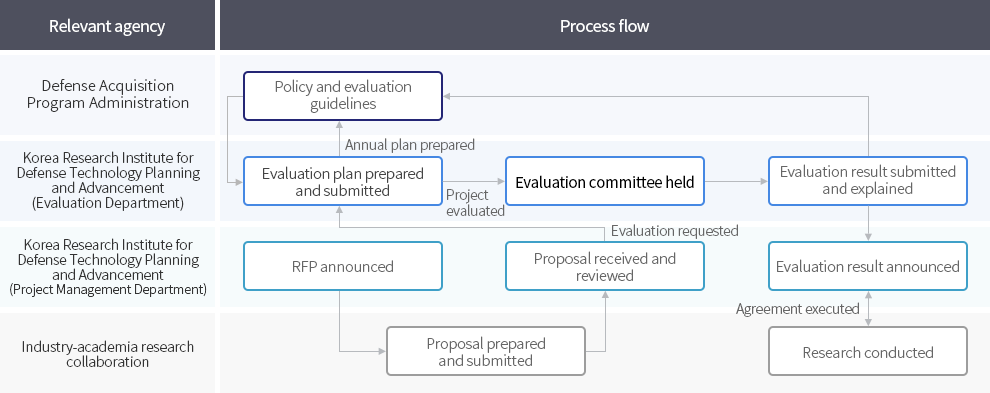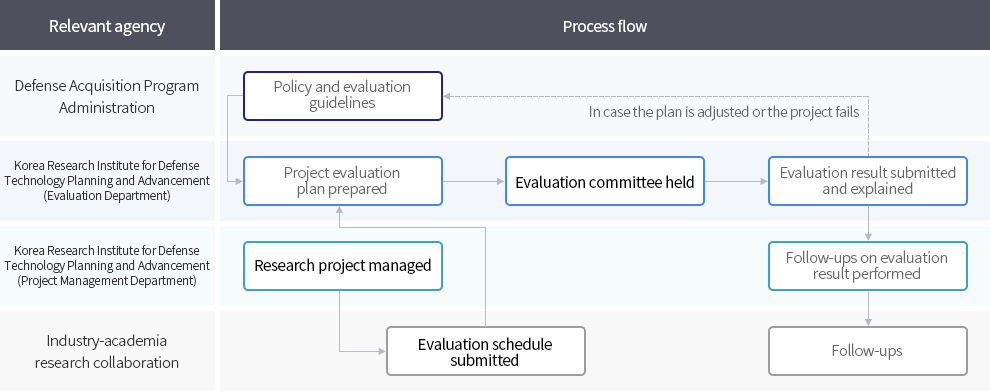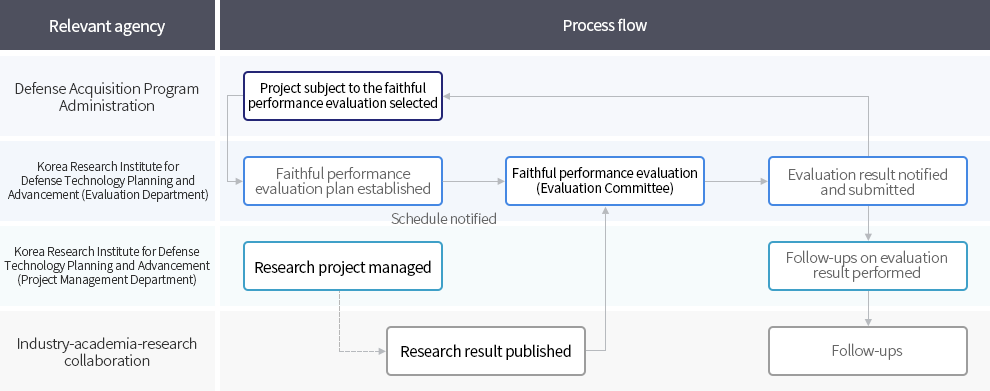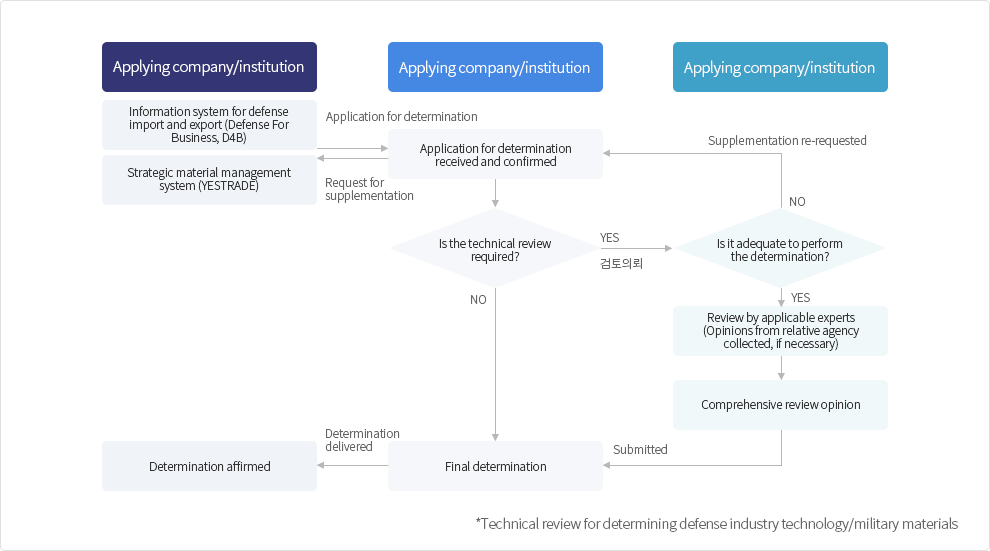Summary
KRIT selects an institution responsible for researching and developing core technologies necessary for weapon systems and conducts an assessment to ascertain the research performance and feasibility.
Purpose
Identifies the required technical areas to develop weapon systems and establishes strategies to supplement them by selecting an institute responsible for developing research projects that primarily handle core technology and by evaluating the outcome thereof
Classification and method of assessment
At this stage, the industry-academia-research consortiums (consisting of enterprises, research institutes, and universities) that want to participate in the core technology development program prepare and submit a research plan to the relevant agency and KRIT selects the most appropriate one among them.

- 관련기관
- 방사청
- 방위산업기술진흥연구소 (평가부서)
- 방위산업기술진흥연구소 (과제관리부서)
- 산학연
- 업무 프로세스
- 산학연에서 제안서 작성/제출, 연구수행 후 협약체결
- 방위산업기술진흥연구소 (과제관리부서)에서 RFP 공고, 제안서 접수 / 검토하고 평가의뢰, 평가결과공고
- 방위산업기술진흥연구소 (평가부서)에서 평가계획 수립 / 제출하여 과제평가 하고 평가위원회 개최, 평가결과제출 / 통보
- 방사청에서 정책/평가지침
This stage aims to check whether the institution conducted an R&D project and obtained the outcome as planned. It consists of an interim evaluation and a final evaluation.

- 관련기관
- 방사청
- 방위산업기술진흥연구소 (평가부서)
- 방위산업기술진흥연구소 (과제관리부서)
- 산학연
- 업무 프로세스
- 산학연에서 평가일정 제출, 후속조치
- 방위산업기술진흥연구소 (과제관리부서)에서 연구과제관리, 평가결과 후속조치
- 방위산업기술진흥연구소 (평가부서)에서 과제평가계획 수립 하고 평가위원회 개최, 평가결과제출 / 통보
- 방사청에서 정책/평가지침(계획조정/과제 실패시)
- Faithful performance evaluation
In this stage, if it is determined that the research has been discontinued or has failed after its performance is evaluated, KRIT reviews whether the research has been faithfully conducted considering the challenges related to the research goal or other external factors.

- 관련기관
- 방사청
- 방위산업기술진흥연구소 (평가부서)
- 방위산업기술진흥연구소 (과제관리부서)
- 산학연
- 업무 프로세스
- 산학연에서 연구결과발표, 후속조치
- 방위산업기술진흥연구소 (과제관리부서)에서 연구과제관리, 평가결과 후속조치
- 방위산업기술진흥연구소 (평가부서)에서 성실수행 평가 계획 수립, 성실수행평가(평가위원회), 평가결과 통보/제출
- 방사청에서 성실수행 평가 대상 선정
Summary
KRIT supports the system for determining defense industry technology to be protected and provides technical support for the schemes to identify strategic materials subject to export control; transfers defense materials, science, and technology; and permits the export thereof.
Purpose
KRIT, for effective export control, supports the review of whether core technologies are applied to the materials to be exported or transferred and protects the technologies prevented from being released for national security among defense sciences and technologies.
Process

- 신청 업체 / 기간
- 방산수출입자원시스템 (D4B) (판정신청)
- 전략물자관리시스템 (YESTRADE)
- 판정결과 확인
- 방위사업청
- 판정신청서 접수 및 확인 (보완요청)
- 기술검토 필요여부 (맞으면 검토의뢰, 아니면 최종판정)
- 최종판정 (판정통보)
- 방위산업기술진흥연구소 (기술보호팀)
- 판정대상 적절성검토(보완필요사항 환류)
- 기술 분야별 전문가 검토 (필요시 관련기관 의견 수렴)
- 종합검토의견 (제출)
*방위산업기술 / 군용물자 판정 기술검토
Summary
The Defense Technology inforMation Service (DTiMS) collects and manages information on defense science, technology, and R&D from multiple defense and private agencies and provides such information to defense agencies, defense companies, and researchers of the industry-academia research consortium.
Purpose
DTiMS promotes active use of defense R&D information through well-structured management, distribution, and utilization of defense science and technology, as well as contributes to the expansion of participation by defense companies and the industry-academia research consortium.
Main Activities
- Provision of key information
- Policy/trend: Manages and provides information, including policy/plan and trends that may be used when establishing defense technology-related policies, specifying requirements, and analyzing trends
- Technology planning: Manages and provides information, including technology research, technology trends, and defense programs that may be used when planning defense technology
- Program/project: Provides information on defense science and technology acquired in performing R&D, deals, or offset trade
- Program performance: Provides performance information such as technical data, reports, and articles acquired in performing R&D, deals, or offset trade
- Mass production: Provides information such as standards for munitions in operation or maintenance, reliability assessment (Ammunition Stockpile Reliability Program and Chemical Materials Stockpile Reliability Program, ASRP/CSRP), component localization data, and other materials on munitions.
Summary
After aggregating and managing information on research facilities and equipment created from defense R&D, the Defense R&D Equipment Information Service (DRES) provides services necessary for redundancy review, operation and maintenance, and joint utilization of defense agencies and the industry-academia-research consortium.
Purpose
Systematically collect and manage information on facilities and equipment created from defense R&D to verify the justification for procuring specific facilities and equipment and ensure efficient execution of defense R&D budgets by making the operation and joint utilization process go on wheels
Main Activities (or Functions)
- Redundancy review: In the deliberation and planning stage for introducing research facility and equipment, identifies similarities or redundancies with existing facilities and equipment
- Management of information on facilities and equipment: Collects and publishes information on existing research facilities and equipment
- Operation and maintenance log: Provides management log covering operation and maintenance activities
- Joint utilization support: Identifies information on facilities and equipment for joint utilization to make such information available to the public and receives applications for joint utilization


